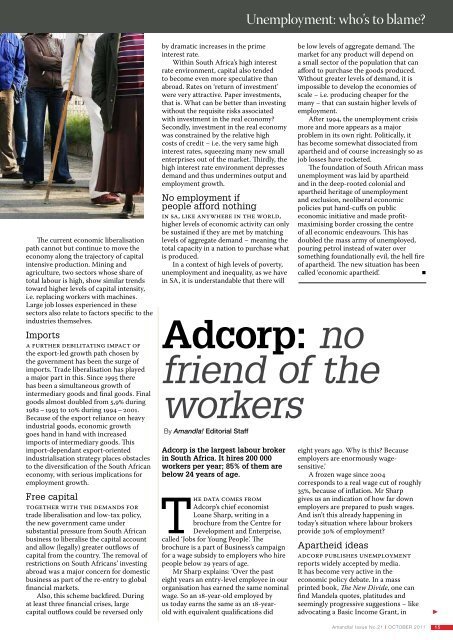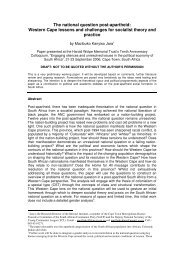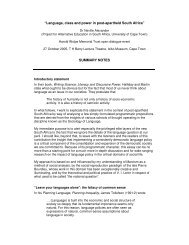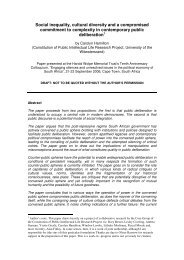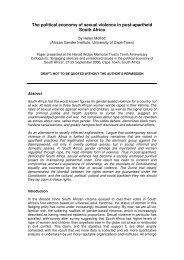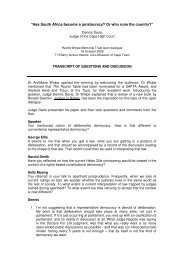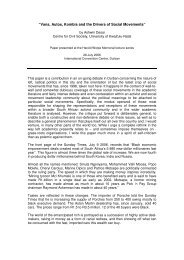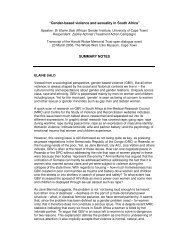here - Amandla!
here - Amandla!
here - Amandla!
You also want an ePaper? Increase the reach of your titles
YUMPU automatically turns print PDFs into web optimized ePapers that Google loves.
Unemployment: who’s to blame?The current economic liberalisationpath cannot but continue to move theeconomy along the trajectory of capitalintensive production. Mining andagriculture, two sectors whose share oftotal labour is high, show similar trendstoward higher levels of capital intensity,i.e. replacing workers with machines.Large job losses experienced in thesesectors also relate to factors specific to theindustries themselves.ImportsA further debilitating impact ofthe export-led growth path chosen bythe government has been the surge ofimports. Trade liberalisation has playeda major part in this. Since 1995 t<strong>here</strong>has been a simultaneous growth ofintermediary goods and final goods. Finalgoods almost doubled from 5,9% during1982 – 1993 to 10% during 1994 – 2001.Because of the export reliance on heavyindustrial goods, economic growthgoes hand in hand with increasedimports of intermediary goods. Thisimport-dependant export-orientedindustrialisation strategy places obstaclesto the diversification of the South Africaneconomy, with serious implications foremployment growth.Free capitalTogether with the demands fortrade liberalisation and low-tax policy,the new government came undersubstantial pressure from South Africanbusiness to liberalise the capital accountand allow (legally) greater outflows ofcapital from the country. The removal ofrestrictions on South Africans’ investingabroad was a major concern for domesticbusiness as part of the re-entry to globalfinancial markets.Also, this scheme backfired. Duringat least three financial crises, largecapital outflows could be reversed onlyby dramatic increases in the primeinterest rate.Within South Africa’s high interestrate environment, capital also tendedto become even more speculative thanabroad. Rates on ‘return of investment’were very attractive. Paper investments,that is. What can be better than investingwithout the requisite risks associatedwith investment in the real economy?Secondly, investment in the real economywas constrained by the relative highcosts of credit − i.e. the very same highinterest rates, squeezing many new smallenterprises out of the market. Thirdly, thehigh interest rate environment depressesdemand and thus undermines output andemployment growth.No employment ifpeople afford nothingIn SA, like anyw<strong>here</strong> in the world,higher levels of economic activity can onlybe sustained if they are met by matchinglevels of aggregate demand − meaning thetotal capacity in a nation to purchase whatis produced.In a context of high levels of poverty,unemployment and inequality, as we havein SA, it is understandable that t<strong>here</strong> willAdcorp: nofriend of theworkersBy <strong>Amandla</strong>! Editorial StaffAdcorp is the largest labour brokerin South Africa. It hires 200 000workers per year; 85% of them arebelow 24 years of age.The data comes fromAdcorp’s chief economistLoane Sharp, writing in abrochure from the Centre forDevelopment and Enterprise,called ‘Jobs for Young People’. Thebrochure is a part of Business’s campaignfor a wage subsidy to employers who hirepeople below 29 years of age.Mr Sharp explains: ‘Over the pasteight years an entry-level employee in ourorganisation has earned the same nominalwage. So an 18-year-old employed byus today earns the same as an 18-yearoldwith equivalent qualifications didbe low levels of aggregate demand. Themarket for any product will depend ona small sector of the population that canafford to purchase the goods produced.Without greater levels of demand, it isimpossible to develop the economies ofscale − i.e. producing cheaper for themany − that can sustain higher levels ofemployment.After 1994, the unemployment crisismore and more appears as a majorproblem in its own right. Politically, ithas become somewhat dissociated fromapartheid and of course increasingly so asjob losses have rocketed.The foundation of South African massunemployment was laid by apartheidand in the deep-rooted colonial andapartheid heritage of unemploymentand exclusion, neoliberal economicpolicies put hand-cuffs on publiceconomic initiative and made profitmaximisingborder crossing the centreof all economic endeavours. This hasdoubled the mass army of unemployed,pouring petrol instead of water oversomething foundationally evil, the hell fireof apartheid. The new situation has beencalled ‘economic apartheid’.eight years ago. Why is this? Becauseemployers are enormously wagesensitive.’A frozen wage since 2004corresponds to a real wage cut of roughly35%, because of inflation. Mr Sharpgives us an indication of how far downemployers are prepared to push wages.And isn’t this already happening intoday’s situation w<strong>here</strong> labour brokersprovide 30% of employment?Apartheid ideasAdcorp publishes unemploymentreports widely accepted by media.It has become very active in theeconomic policy debate. In a massprinted book, The New Divide, one canfind Mandela quotes, platitudes andseemingly progressive suggestions − likeadvocating a Basic Income Grant, in<strong>Amandla</strong>! Issue No.21 | OCTOBER 2011 15


